|
|
|
Published
on 13
May 2008
|
All rights reserved.
|
|
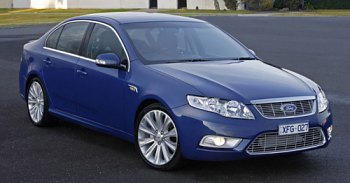 G6E Turbo combines good looks,
strong performance and smooth ride...
G6E Turbo combines good looks,
strong performance and smooth ride...
It
is amazing that under the trend of globalization and platform sharing,
Ford still keeps its Australian big car Falcon independent. Since the
early 1970s, Falcon has been designed, engineered and produced in
Australia. It serves mostly the Australia and New Zealand market, where
it topped sales chart many times. Recently, sales of this rear-drive
big family car has been declining - the same goes for its arch-rival
Holden Commodore - and its domination of the local market has been
replaced by the more fuel-efficient Toyota Camry. Nevertheless, Aussies
are still proud of Falcon, as it represents Australian automotive
industry. They must be grateful that Ford keeps the new generation FG
Falcon engineered and produced exclusively in Australia.
The FG Falcon replaces the outgoing generation, AU / BA / BF Falcon
which had been around for 10 years. From engineering point of view, FG
is not exactly a big leap from the old car, because the latter had
already got a major re-engineering in 2003 (such as new independent
rear suspensions and new multi-valve engines) thus was considered to be
modern enough. The old Falcon was also big enough, so the new car has
barely grown a little (25mm longer, 4mm wider and 10mm longer
wheelbase). What the old car really felt outdated were its organic
exterior design and cheap interior packaging. In the new car, exterior
design is updated. Although it is by no means striking, it looks
comfortable to our eyes. Well, you may describe the base model XT as
bland and the sporty model XR (either XR6 or XR8) as a bit too
civilized, but in luxurious form G-series (G6 or G6E), with chromed
mesh grilles and chromed window frames it looks every bit an European
design. If not the current Mondeo grown so big (actually as big as
Falcon), Ford Europe could have considered importing the G-series
Falcon as the replacement of its defunct big car Scorpio !
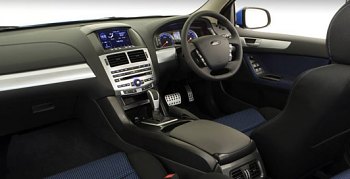 Cabin used to be the weakness of
Australian cars, no more to FG Falcon...
Cabin used to be the weakness of
Australian cars, no more to FG Falcon...
Australian
cars have been notorious for poor quality interior. This was true to
the old Falcon as well as today's Holden VE Commodore. Gratefully, the
new Falcon gets a much improved dashboard and instrument made of decent
plastics. Although still lags behind the quality standard of Camry and
Mondeo, it is no longer a complaint to most people. Not so good are the
driving position (too high and adjustment range is limited) and seat
comfort (not very supportive). Nevertheless, the cabin feels roomier
than before, thanks to less steeply raked windscreen and rear window.
Rear passengers will also find access to the cabin easier due to the
larger door aperture. As before, the rear seat can genuinely
accommodate 3 adults, although they won't find as much legroom and
headroom as in Holden Commodore.
As expected, the FG Falcon remains rear-wheel drive, which is a delight
to traditional motorists. Its new chassis is stronger and safer. Though
still ride on double-wishbone front suspensions and "control-blade"
multi-link rear suspensions, it is not lack of improvements. For
example, the control arms of the front suspensions are now made of
aluminum to save 22kg of unsprung weight. The rear suspension has
higher roll center to match with the front and reduce body roll. New
bushings, monotube dampers and 30 mm wider tracks improve handling as
well as NVH suppression. Besides, the steering rack is now mounted
forward to stabilize the steering response, and variable ratio rack is
used for the first time. Lastly, to tame the previous scary oversteer -
something inevitable for a powerful rear-drive machine - a modern
electronic stability control is finally added.
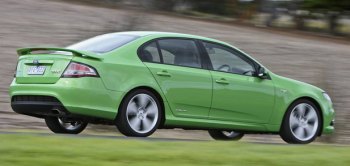 XR6 has sportier suspensions and extra
aero kits
XR6 has sportier suspensions and extra
aero kits
Powertrain
gets plenty of improvements, too. The old 5-speed manual gearbox has
been replaced by a Tremec 6-speed manual box. The old 4-speed automatic
has been upgraded to a 5-speed unit built by Ford Europe. More
expensive models employ ZF's 6-speed automatic, what else can you ask
for ?
The base engine continues to be that 4.0-liter straight-six with 24
valves, double VCT variable cam phasing and (unfortunately) the same
cast-iron block. However, it gets a new composite intake manifold with
resonance type variable volume function to optimize torque spread and a
new cylinder head with reshaped combustion chambers to promote swirl.
Max output is 261hp and 288 lb-ft, 7hp and 6 lb-ft up from last
generation.
Next up is turbocharged version of the straight-six. Now with 362
horsepower and 393 lb-ft of torque, it is actually on a par with the
V8. Compare with the old engine, it gets a new cylinder head and a
composite intake manifolds like the naturally aspirated engine (but
with fixed geometry because the torque of turbocharging is so strong).
A new Garrett turbocharger, accompany with shorter intake and lower
exhaust back pressure, responds 30% faster to throttle. Turbo lag is
reduced, torque curve is improved. 80% max torque is now available from
1250-5750 rpm, while max torque continues from 2000-4750 rpm. Bigger
intercooler and higher efficiency turbocharger allows boost pressure to
increase from 0.4 to 0.7 bar, resulting in 34 more horsepower.
Moreover, the variable cam phasing of this engine is adaptive to
driving mood - when the throttle is wide open, it switches to an
aggressive valve timing to reduce turbo lag and sharpen engine
response. In normal driving, the cam timing is less aggressive so that
the car delivers 5% lower fuel consumption compare with the old car.
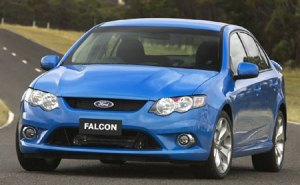 On the road, XR8 is the most
disappointing...
On the road, XR8 is the most
disappointing...
On
the top of the tree is the familiar Boss 290 5.4-liter 32-valve V8,
hand-assembled by FPV (Ford Performance Vehicle). It produces 389 hp
and 383 lb-ft of torque, probably not enough to persuade customers to
choose it instead of the turbocharged 6. Admittedly, Australia Ford is
phasing out V8 engines under the pressure of high fuel price. Therefore
it simply dropped the mass production 3-valve V8 and offers only the
low volume Boss 290 to the new Falcon. It is reserved for the XR8
model. Expect only the traditional V8 hardcores will be interested.
On the road, XR8 is the most disappointing. Wheels magazine found it is
actually slower than the torquer XR6 Turbo by quite a margin. Moreover,
its big V8 make it feels nose-heavy in corners and results in stronger
understeer. Its exhaust noise is also too civilized for a V8 machine.
In addition to the heavy fuel consumption, there is no reasons at all
to purchase it instead of the XR6 Turbo, unless you are a V8 die-hard !
Both XR6 Turbo and G6E Turbo are deeply impressive. They share the same
turbocharged six with the same refinement, flexible torque and
the same astonishing performance: 0-60 mph take just 4.9 seconds when
they are equipped with the excellent ZF 6-speed automatic ! The main
difference between them is suspension tuning. The softer-riding G6E
Turbo is a great high-speed cruiser while XR6 Turbo is more fun in
corners. However, even the XR6 has smoother ride than rival Commodore
SS-V.
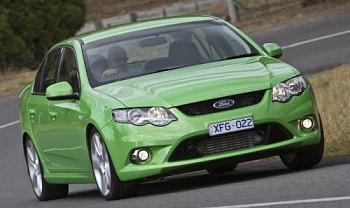 Even the XR6 has smoother ride than
rival Commodore SS-V
Even the XR6 has smoother ride than
rival Commodore SS-V
All
Falcons have well-sorted handling and ride. Their tuning induces slight
initial understeer but could be balanced by throttle. Their steering is
accurate, linear and communicative, although the rack could transmit
rattle on bumpy surfaces. Overall speaking, Falcon has better chassis
dynamics than VE Commodore. In addition to its stronger engines and
better transmissions, it can easily steal the crown from its domestic
rival.
However, questions remain over the future of the Australian big car.
Declining interests in big family cars and a more open domestic market
means Australia and New Zealand can hardly support an independent line
of vehicle. Globalization is the only way for survival in the future.
GM let Holden to lead the development of Zeta platform for use in North
America and China. Will Ford allow its Australian arm to do the same ?
Let's hope so. |
Verdict:
    |
Published
on 19
Jun 2008
|
All rights reserved.
|
|
FPV Falcon F6 and GT
|
FPV,
or Ford Performance Vehicle, is a joint-venture between Australian Ford
and British racing / tuning / engineering consultant Prodrive. The
formation of FPV was a response to Holden’s HSV in order to lure
Australian performance cars lovers as well as to lift the company
image. Through the years FPV has been concentrating on modifying
Falcon. This time is no exception. For the FG series Falcon, FPV offers
mainly two models: the six-cylinder turbocharged F6 and the V8-powered
GT, which are based on the production XR6 Turbo and XR8 respectively.
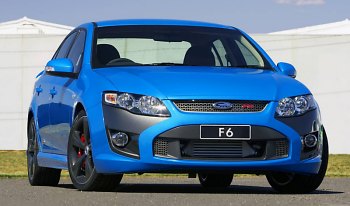 F6: superior torque delivers instant
pull at any rev and any gears...
F6: superior torque delivers instant
pull at any rev and any gears...
F6:
4.0 turbo
Externally, the F6 looks a lot more aggressive than its donor car,
thanks to a radical mask design, aero kits upgrade and 19-inch graphite
alloy wheels through which you can see the red brake calipers. The open
lower intake gives free access to the enlarged intercooler. A larger
intercooler is required because FPV dialed up the boost pressure of the
turbocharged straight-six from 0.7 to 0.91 bar, accompany with other
inevitable modifications such as a slightly lower compression ratio
(down from 8.7 to 8.5:1), strengthened pistons and con-rods and a freer
intake system. The result is 53 more horsepower at the top end (now 415
horses in total), and a stronger yet broader torque curve – some 416
lb-ft is available from 1950 rpm continuously to 5200 rpm !
On the road, this tremendous torque translates to sensational
acceleration. We believe given a skillful launch it can finish 0-60 mph
in 4.8 seconds and 0-100 mph in about 11 seconds. Though not
enough to mount a challenge to BMW M3, its superior torque delivers
instant pull at any rev and any gears. Speaking of gears, F6 offers a
Tremec 6-speed manual or ZF 6-speed auto like the XR6 Turbo. We would
choose the latter because it costs the same, loses no performance to
the manual and promotes the effortless performance character of the car.
Modifications to the chassis are quite mild. FPV did not alter the
suspension geometry, only firmed up the springs at front suspensions a
little and softened the rear springs a little for better dynamic
balance. Sportier Dunlop Sport Maxx 245/35ZR19 tires and Brembo brakes
(335mm discs and 4-pot calipers front; 328mm discs and single-pot
calipers rear) complete the chassis mods. Ride quality and quietness
suffer a little, but overall speaking the F6 remains comfortable by the
standard of sports sedans. Grip and body control are both improved
slightly from the already good XR6 Turbo.
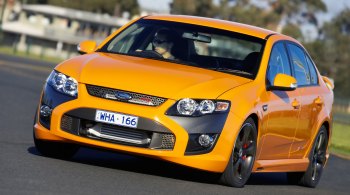 Performance and handling-wise, the
upgrade from XR6 Turbo to F6 is not as big as its appearance
suggested...
Performance and handling-wise, the
upgrade from XR6 Turbo to F6 is not as big as its appearance
suggested...
However,
the F6 has some weaknesses. Firstly, its wet weather handling is
questionable because the tremendous torque may overwhelm its rear-wheel
traction if you are not extremely careful on throttle. Secondly, like
the regular Falcon, its steering kickbacks on coarse surfaces, although
we have no complaint on its accuracy and feel. Thirdly, its standard
brakes are not powerful enough to handle extended hard use, so you had
better to tick the upgraded Brembo brake package which consists of
355mm cross-drilled discs and 6-pot calipers up front and 330mm discs
and 4-pot calipers at the rear. Fourthly, its sheer size and weight
make it less exploitable on mountain roads than the compact M3,
C63 AMG or RS4. Admittedly, this is a common problem of Australian
sports sedans.
Lastly but not least, in terms of performance and handling the upgrade
from XR6 Turbo to F6 is not as big as its appearance suggested. Many
people will be satisfied with the competent XR6 Turbo and regard the
extra cost of F6 hard to justify. In Australia, the F6 costs A$66,000
against XR6 Turbo’s A$45,500. Equip it with the must-have brake upgrade
and leather trim interior, the F6 will set you back at A$74,000. That
is still significantly cheaper than the European imports, but an
imported Chrysler 300C SRT-8 asks for the same money in Australia. That
make you wonder how much it will charge if it is exported to a
third-party country like the United States. My estimation is it will be
pricier than BMW 335i M-Sport and runs near the territory of M3 sedan.
Are you willing to pay so much money for a Ford ?
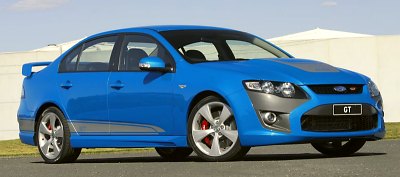 Ironically, GT needs those visual
drama to compensate for its lack of real talent...
Ironically, GT needs those visual
drama to compensate for its lack of real talent...
GT:
5.4 V8
The V8-powered GT faces the same problems. Some may think its “BOSS
315” 5.4-liter DOHC V8 may claw back a few points, but in reality the
V8 is no where as powerful as the 4.0 turbocharged straight-6. FPV
smoothened its intake and exhaust to deliberate its top end to 6500
rpm. This results in 422 horsepower, only 7 hp more than F6. However,
the V8 loses decisively to the turbocharged six in torque output – it
produces less (406 lb-ft vs 416 lb-ft) yet the peak arrives at a high
4750 rpm. The relatively peaky torque curve dictates its acceleration
performance. We estimate it will take 5.5 seconds to go from 0-60 mph,
slower than most performance sedans on the market, especially at this
price.
The GT can be distinguished from F6 by its power bulge over the bonnet
and some fancy graphics. Ironically, such visual drama is necessary to
compensate for its lack of real talent. Modifications to the chassis is
the same as F6, so apart from more nose-heaviness – which means more
understeer, pitch and dive – we have nothing to add.
The V8 model used to be the flagship of FPV. However, knowing its
inferior performance this time Ford does not dare to charge any higher
price than the
F6. Still, there are not many reasons to choose it instead of the more
competent F6. V8-diehards may prefer it, but then again HSV has better
offerings. Taking oil price and emission into account, the days of FPV
GT could be numbered. |
Verdict:
F6:    
GT:  
|
Published
on 22
Jan 2011
|
All rights reserved.
|
|
FPV GT Boss 335
|
We dislike the outgoing FPV GT for its lukewarm performance and
nose-heavy handling. Now with a more powerful yet lighter engine, maybe
it deserves a second chance. Replacing the old 5.4-liter iron-block V8
is an all-aluminum V8 based on the one serving the American Ford
Mustang 5.0 GT. It saves 47 kilograms from the front axle, yet comes
with modern intake and exhaust variable valve timing. On the top of
that, Prodrive (co-owner of FPV) added a supercharger into its
V-valley. The supercharger is based on the internals of Eaton TVS, with
four-lobe rotors like those on Audi S4, Corvette ZR1 and Jaguar XFR to
enhance efficiency. However, to fit into the Ford V8, Australian
performance engineering firm Preston custom-made a housing for it. As
you can see in the picture below, the whole thing looks quite
after-market.
Considering the Mustang V8 is already capable of 412 horsepower and 390
lbft of torque, we should expect the supercharged version to pump out
the north of 500 hp and 500 lbft, shouldn't we ? Unfortunately, the
aftermarket approach of modifications mean there is no intercooler
included, thus the supercharger has to run a light boost pressure
limited to 0.4 bar. Consequently, its output is only 450 hp and 420
lbft. Very disappointing, isn't it ?
That said, on the road the supercharged V8 feels far more energetic
than the old engine, thanks to its thicker mid-range torque. On the
other hand, it also spins more freely to its 6200 rpm redline. This
should shorten its 0-60 mph sprint from 5.5 to sub-5 seconds, although
the official time of 4.7 sec might be a little optimistic. We are still
not quite satisfied with such performance, but to be fair, you can
hardly ask for more from this price range. Despite of a small price
bump, the car is still cheaper than a BMW 335i in Australia.
Moreover, the Boss 335 engine (the number refers to its output in kW)
has improved on sound quality as well. Its exhaust note gets louder and
more exciting, thanks to a two-stage exhaust that is tuned to release
angrier bark at high rev.
Less improved is handling. The lighter load on front axle can be felt,
but it does not make a night-and-day difference to handling. Overall,
the big Falcon is still more floaty in corners and over undulation than
European performance sedans. Its softer suspension setting leads to
more pitch, roll and understeer. Its unsophisticated axle and
electronics also struggle to put down all the power on the road through
its rear tires. In the age of E-diff, torque-vectoring and adaptive
suspensions, the big Falcon looks hopelessly outdated. |
Verdict:    |
Published
on 11
Jun 2012
|
All rights reserved.
|
|
Falcon FG Mk2 and 2.0 Ecoboost
|
Ford Australia gave
the FG
series Falcon a facelift late last year. Breaking away from tradition,
this car is called FG Mk2 rather than given a new series name. It makes
sense, because the modifications done are modest. The nose of the car
is revised with a slimmer upper grille and an octagonal lower grille.
The fog light assemblies are also restyled. Inside, there are some
minor equipment updates but the environment is unchanged, which means
both the design and quality fall behind modern standards.
Coming together with the facelift is the addition of 2.0 Ecoboost
engine. The big Falcon has always been using 6-cylinder engines, but
the call for reduced fuel consumption led to the adoption of the
European 2.0-liter Ecoboost four-cylinder. Similar to the one fitted to
Mondeo, but turned to longitudinal position and tuned to produce 240 hp
and 260 lbft of torque, it trails the 4-liter straight-six by not much.
A flatter torque curve and lighter weight means it loses to the 4-liter
car by only a tenth in 0-60 mph, so the 18 percent boost in fuel
economy comes nearly free.
The Ecoboost engine is 64 kg lighter than the iron-block straight-6. It
is also considerably shorter. Both factors lead to the front-to-rear
weight distribution improved from 56:44 to 54:46. Moreover, the 2.0
Ecoboost car is fitted with slightly stiffer suspensions, so it
displays better handling. Subjectively, the straight-six is still
preferred for its faster throttle response, linear power delivery and
superior smoothness.
If Ecoboost is proved to be popular, it could threaten the future of
the six-cylinder engine, which is widely speculated to die in a few
years' time. Whether it can save the Australian-built Falcon from the
axe is another matter. Last year, the domestic sales of Falcon dropped
to a miserable 18,741 units, blame to the market trend that shift away
from big cars (Holden Commodore and Toyota Aurion are also in the fall,
though not as bad as Falcon). |
Verdict:    |
| Published
on 29
Jul 2014 |
All rights reserved.
|
|
FPV GT F 351
|
|
No matter you like
or not, Australian motor industry is cruising to sunset. Owing to high
production costs and limited demand, Ford and Holden decided to quit
manufacturing in Australia by late 2016 and 2017 respectively. This
means the final death of both Falcon and Commodore and the end of their
legendary rivalry. Ford’s performance division, FPV, will be shut even
earlier, expected at the end of this year. The car seen here is its
last product.
The name GT F 351 implies two things – the F means Final for obvious
reasons, and the number refers to its power in kilowatt. For a final
edition with only 500 units to be built (plus another 120 pickups), you
won’t expect any costly modifications. That is true. The 5-liter
supercharged V8 with nickname “Miami” is the same as the existing one
on GT Boss 335, just with a remapped ECU to release another 20
horsepower, or 470 hp in absolute terms. This can be overboosted
further to 542 hp for up to 20 seconds, though the old engine also had
this feature. Maximum torque is unchanged at 420 lbft, a relatively low
figure these days. The company said 0-60 mph dips by a couple of tenths
to 4.4 seconds, but in the real world its extra power and performance
are hard to detect without driving the old car back to back. HSV’s
supercharged Gen-F GTS is obviously faster.
You can’t distinguish the GT F from the old car without looking at its
paint stripes, as there is no new body parts at all. Likewise, changes
to the interior are limited to some minor things. However, once put the
car in corners you can tell the difference, because it gets R-spec
package
as standard. This includes stiffer springs and dampers, thicker rear
anti-roll bar, firmer strut mounts, 20 mm wider rear tires and stronger
Brembo brakes. It feels less nose-heavy, more willing to turn-in and
rolls a lot less in corners, although ride comfort suffers a little.
That said, the improvements are probably too small and too late. As a
final edition, it fails to leave us an unforgettable impression.
|
Verdict:    |
Published
on 21
Jan 2015
|
All rights reserved.
|
|
The ultimate Falcon - FG X
|
|
It is always a deep
sorrow to say goodbye to an iconic car. Ford Falcon has been around
Australian motorists since 1960. Together with Holden Commodore it used
to be the symbol of Australian motor industry. However, since a decade
ago its sales have been declining every year, from 73,220 units in 2003
to a miserable 6,349 units last year. Some attributes this to the
market trend towards smaller and more frugal cars. Some blame the
lowering tariffs – back in the late 1980s, the government was still
charging 45 percent tariffs on imported cars. That was gradually
lowered to 15
percent in year 2000, 10 percent in 2005 and then 5 percent from 2010.
Without tax protection, the Australian motor industry is hard to
compete with Japanese and Korean cars, because its local manufacturing
cost is much higher – Ford said it is twice as much as its European
plants! Eventually, the firm decided to cease production of Falcon and
shut down the Australian factory by October next year. Before that
happens, the Falcon is given its last and ultimate facelift. Its
codename is FG X.
Predictably, Ford is not going to invest heavily into this swan song.
All engines and gearboxes are carried over unchanged, as is the
chassis. However, it gets a desperately needed facelift. The
Aston-Martin-style new corporate grille and slim-line headlamps fit
amazingly well into the 7-year-old car, proving that a
well-proportioned body is great for any dresses. Meanwhile, the tail is
made more elegant by using slim taillights linked by a chromed bar.
Overall, the FG X looks a lot handsomer than before.
Sadly, the cabin is left unchanged. 7 years ago it might look modern
enough, but today it feels dated and cheap. Ergonomics remains poor, as
the driver seat is mounted too high and the steering wheel is set too
low. Rear passengers are much happier. As you would
expect for an Australian large car, there is plenty of space for 3
full-size adults. Standard equipment is more generous in this ultimate
version. It gets the reputed Sync connectivity system which is easy to
connect to smartphones and give voice commands.
Although no engines are new, they have been reshuffled to different
models. The base Falcon, executive-oriented G6E and sporty XR6 are
fitted with the venerable normally aspirated 4-liter straight-six with
261 hp. The former two may get optional 2.0 Ecoboost four with 240 hp.
The storming 362 hp 4.0 straight-six turbo can be found under the
bonnet of XR6 Turbo or G6E Turbo. On the top of the tree, XR8 returns.
It is now benefited by the Miami 5-liter supercharged V8 previously
serving FPV GT Boss 335, offering 450 horsepower hence sub-5-seconds
0-60 mph. As FPV division has already been shut down, this is the last
chance Australian motorists can buy the performance Falcon.
Being one of the last two Australian-built rear-wheel-drive cars, the
FG X does not disappoint keen drivers. Even the cooking models offer
good performance, nice handling and supple ride. If not because of poor
fuel economy and cheap interior, it would still be a highly
recommendable choice, especially now with a handsome face. It will
leave us a fond memory forever.
|
Verdict:    |
|
|
|
|
|
|
|
|
|
|
Falcon
G6E
|
2008
|
Front-engined,
RWD
|
| Steel monocoque |
| Mainly steel |
| 4967 / 1868 / 1453 mm |
| 2838 mm |
Inline-6
|
| 3984 cc |
DOHC 24 valves, DVVT
|
| - |
| - |
| 261 hp |
| 288 lbft |
| 6-speed automatic |
F: double-wishbones
R: multi-link
|
| - |
| 235/50R17 |
1704 kg
|
| - |
6.7 (est)
|
| - |
|
Falcon
XR6 Turbo
|
2008
|
Front-engined,
RWD
|
| Steel monocoque |
| Mainly steel |
| 4970 / 1868 / 1453 mm |
| 2838 mm |
Inline-6
|
| 3984 cc |
DOHC 24 valves, DVVT
|
| Turbo |
| - |
362 hp / 5250 rpm
|
393 lbft / 2000-4750 rpm
|
| 6-speed automatic |
F: double-wishbones
R: multi-link
|
| - |
| 245/40ZR18 |
1694 kg
|
| - |
4.9*
|
| - |
|
Falcon
XR8
|
2008
|
Front-engined,
RWD
|
| Steel monocoque |
| Mainly steel |
| 4970 / 1868 / 1453 mm |
| 2838 mm |
V8, 90-degree
|
| 5408 cc |
DOHC 32 valves
|
| - |
| - |
389 hp / 5750 rpm
|
383 lbft / 4750 rpm
|
| 6-speed automatic |
F: double-wishbones
R: multi-link
|
| - |
| 245/40ZR18 |
1770 kg
|
| - |
5.7*
|
| - |
|
|
|
|
|
Performance
tested by: *Wheels
|
|
|
|
|
|
|
FPV Falcon F6
|
2008
|
Front-engined,
RWD
|
| Steel monocoque |
| Mainly steel |
| 4955 / 1868 / 1433 mm |
| 2838 mm |
Inline-6
|
| 3984 cc |
DOHC 24 valves, DVVT
|
| Turbo |
| - |
415 hp / 5250 rpm
|
416 lbft / 1950-5200 rpm
|
| 6-speed automatic |
F: double-wishbones
R: multi-link
|
| - |
| 245/35ZR19 |
1822 kg
|
| 155 mph (limited) |
5.0*
|
| - |
|
FPV
Falcon GT
|
2008
|
Front-engined,
RWD
|
| Steel monocoque |
| Mainly steel |
| 4970 / 1868 / 1453 mm |
| 2838 mm |
V8, 90-degree
|
| 5408 cc |
DOHC 32 valves
|
| - |
| - |
422 hp / 6500 rpm
|
406 lbft / 4750 rpm
|
| 6-speed manual |
F: double-wishbones
R: multi-link
|
| - |
| 245/35ZR19 |
1881 kg
|
| 155 mph (limited) |
5.5 (est)
|
| - |
|
FPV
GT Boss 335
|
2010
|
Front-engined,
RWD
|
| Steel monocoque |
| Mainly steel |
| 4968 / 1868 / 1453 mm |
| 2838 mm |
V8, 90-degree
|
| 4951 cc |
DOHC 32 valves, DVVT
|
| Supercharger |
| - |
450 hp / 5750 rpm
|
420 lbft / 2200-5500 rpm
|
| 6-speed manual |
F: double-wishbones
R: multi-link
|
| - |
| 245/35ZR19 |
1855 kg
|
| 155 mph (limited) |
4.7 (c)
|
| - |
|
|
|
|
|
| Performance
tested by: *Wheels |
|
|
|
|
|
|
Falcon
G6
2.0 Ecoboost
|
2012
|
Front-engined,
RWD
|
| Steel monocoque |
| Mainly steel |
| 4967 / 1868 / 1433 mm |
| 2838 mm |
Inline-4
|
| 1999 cc |
DOHC 16 valves, DVVT
|
| Turbo |
| DI |
240 hp
|
| 260 lbft |
| 6-speed automatic |
F: double-wishbones
R: multi-link
|
| - |
235/50R17
|
1648 kg
|
| - |
6.8 (est)
|
| - |
|
FPV
GT F 351
|
2014
|
Front-engined,
RWD
|
| Steel monocoque |
| Mainly steel |
| 4968 / 1868 / 1453 mm |
| 2838 mm |
V8, 90-degree
|
| 4951 cc |
DOHC 32 valves, DVVT
|
| Supercharger |
| - |
470 hp / 6000 rpm
(overboost 542 hp)
|
420 lbft / 2500-5500 rpm
|
6-spd manual or 6-spd auto
|
F: double-wishbones
R: multi-link
|
| - |
F: 245/35ZR19
R: 275/35ZR19
|
1855 kg
|
| 155 mph (limited) |
4.4 (c)
|
| - |
|
|
|
|
|
|
Performance tested by: -
|
|
|
|
|
|
|
Falcon G6E
2.0 Ecoboost
|
2014
|
Front-engined,
RWD
|
| Steel monocoque |
| Mainly steel |
| 4949 / 1868 / 1494 mm |
| 2838 mm |
Inline-4
|
| 1999 cc |
DOHC 16 valves, DVVT
|
| Turbo |
| DI |
240 hp
|
| 260 lbft |
| 6-speed automatic |
F: double-wishbones
R: multi-link
|
| - |
245/40R18
|
1668 kg
|
| - |
6.8 (est)
|
| - |
|
Falcon XR6 Turbo
|
2014
|
Front-engined,
RWD
|
| Steel monocoque |
| Mainly steel |
| 4949 / 1868 / 1494 mm |
| 2838 mm |
Inline-6
|
| 3984 cc |
DOHC 24 valves, DVVT
|
| Turbo |
| - |
362 hp / 5250 rpm
|
393 lbft / 2000-4750 rpm
|
| 6-speed automatic |
F: double-wishbones
R: multi-link
|
| - |
245/35R19
|
1793 kg
|
| - |
5.0 (est)
|
| - |
|
Falcon
XR8
|
2014
|
Front-engined,
RWD
|
| Steel monocoque |
| Mainly steel |
| 4949 / 1868 / 1494 mm |
| 2838 mm |
V8, 90-degree
|
| 4951 cc |
DOHC 32 valves, DVVT
|
| Supercharger |
| - |
450 hp / 5750 rpm
|
420 lbft / 2200-5500 rpm
|
| 6-speed automatic |
F: double-wishbones
R: multi-link
|
| - |
F: 245/35ZR19
R: 275/35ZR19 |
1861 kg
|
| 155 mph (limited) |
4.7 (est)
|
| - |
|
|
|
|
|
| Performance tested by: - |
|
|
|
|
|
|
|
|
Copyright©
1997-2015
by Mark Wan @ AutoZine
|
|